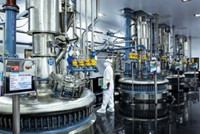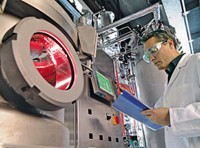Advertisement
Grab your lab coat. Let's get started
Welcome!
Welcome!
Create an account below to get 6 C&EN articles per month, receive newsletters and more - all free.
It seems this is your first time logging in online. Please enter the following information to continue.
As an ACS member you automatically get access to this site. All we need is few more details to create your reading experience.
Not you? Sign in with a different account.
Not you? Sign in with a different account.
ERROR 1
ERROR 1
ERROR 2
ERROR 2
ERROR 2
ERROR 2
ERROR 2
Password and Confirm password must match.
If you have an ACS member number, please enter it here so we can link this account to your membership. (optional)
ERROR 2
ACS values your privacy. By submitting your information, you are gaining access to C&EN and subscribing to our weekly newsletter. We use the information you provide to make your reading experience better, and we will never sell your data to third party members.
Business
Oxyrane Aims High in Biotechnology
South African team turns isolation to its advantage in developing biocatalysts
by Patricia L. Short
October 24, 2005
| A version of this story appeared in
Volume 83, Issue 43

Early this year saw the formation of a new company, Johannesburg-based Oxyrane, to commercialize research into epoxide hydrolase biocatalysis. The technology was developed by a team led by Adri Botes within a partnership between the University of the Free State and CSIR, an industrial research institute. Oxyrane is a privately funded spin-off from these institutions.
Now the company is working hard on two fronts. Backed by several patents, it is commercializing the resulting technology as a cost-effective green route for the production of chiral epoxides. It is also building in South Africa a technology-based company that is strong enough to compete on the world stage.
From dipping a toe in the water at the June ChemSpec specialty chemical exhibition in Dsseldorf, Michael Campbell, chief executive officer, and Robin Mitra, process operations director, will spearhead the companys debut at the CPhI pharmaceutical ingredients show in Madrid next month. They will be presenting a market-ready technology that uses biocatalysts to produce a wide range of chiral epoxides and chiral bifunctional -derivatives.
The concept of epoxide hydrolase enzymes is not new. As Mitra points out, various European and U.S. researchers have tried to develop the same biocatalytic routes, but with limited success.
Working in Johannesburg, researchers tackled the same problem. Being geographically remote from the mainstream scientific community, however, the researchers were free to tackle the problem in new or unorthodox ways—in a way, a modern, biotech version of the work in coal gasification that was done by the politically isolated company Sasol during the apartheid era.
Being outside the mainstream, Mitra explains, was useful: We needed to maintain a low profile internationally while our intellectual property position was defined in this very competitive space. However, we could still easily track any pertinent developments by researchers in the rest of the world, and we knew early in the project that we had something special.
Campbell adds, We think this technology applies to about one-third of all the targets that may come up. Moreover, he says, the technology was specifically designed from inception to be chemical-plant friendly.
According to Mitra, the main competitive routes are the Sharpless asymmetric processes and the Jacobsen hydrolytic kinetic resolution process, all of which employ heavy-metal-based chemical catalysts to resolve racemic epoxides to produce chiral epoxides and diols. The catalyst system in Oxyranes technology contains high levels of epoxide hydrolase to achieve the same degree of resolution on a broader range of epoxide substrates, the company claims.
We know people wont single-source out of South Africa, but the technology and the skills are as good as anywhere in the world.
INITIALLY, Mitra says, Oxyrane planned to focus solely on production of novel chiral synthons such as di- and trisubstituted epoxides that would be of interest to the pharmaceutical industry. The company has found, however, that its technology is competitive in producing a broad range of chiral epoxides already produced through chemical synthesis.
As a result, Mitra notes, our business model has now expanded to include application to semi-commodity-scale chiral epoxides such as phenyl glycidyl ether, benzyl glycidyl ether, glycidyl tosylates, chiral halogenated- and nitro-styrene oxides, and chiral epoxyalkanes. Such products are used in agrochemicals, flavors, fragrances, and optically active polymers.
Because the companys primary focus is pharma applications, Mitra says, we are currently identifying key partners to move forward the use of our technology in these other significant application areas.
The company has formulated a six-point business strategy:
◾ In-house small-scale production up to 10 kg.
◾ Relationships with European and U.S. chemical catalog companies for distribution of R&D quantities.
◾ Partnerships with custom manufacturers of chiral intermediates with access to current Good Manufacturing Process-compliant facilities.
◾ Partnerships for toll production of commodity chiral molecules at low cost.
◾ Partnerships with players in nonpharma industries to develop opportunities outside the pharmaceutical sector.
◾ In-house identification and development of chiral epoxide routes to active pharmaceutical ingredients.
Mitra argues that, from a biotechnology perspective, the quality and applicability of Oxyranes technology should stir a traditionally skeptical chemical industry.
The company already has some supporters, particularly in the academic field. For example, Stanley M. Roberts, chemistry professor at the University of Manchester, in England, says that in his opinion, Adri Botes and the Oxyrane team have made some exciting advances in the use of epoxide hydrolases in synthetic organic chemistry.
Roberts points out that the stereocontrolled hydrolysis of epoxides using enzymes has been established over the past few years, but the South African group has developed the technology quite radically, to produce a portfolio of epoxide hydrolases, each with characteristic substrate selectivities.
The opportunity stereoselectively to open meso-epoxides to give optically active diols—for example, trans-cyclohexane-1,2-diol—is particularly interesting, Roberts adds. There is no reason to believe that the biotransformation will be difficult to scale up; hence I predict that industries involved in producing specialty chemicals, including pharmaceutical intermediates, will be attracted to this methodology.
Campbell joined Oxyrane at its inception early this year with a mandate to advance the initial rounds of investor funding, drawn primarily from South Africa and North America. As he notes, the easy route to exploiting the CSIR research would have been to immediately sell the opportunity to commercial parties overseas with no long-term benefit for South Africa. Instead, the founders decided to go for the unusual—and risky—option of setting up an independent biotechnology company operating largely out of Johannesburg.
There are strengths in the company that are unique, Campbell says. Are there constraints of operating in South Africa? Absolutely, yes, he concedes. But reproducing the team and skills would be immensely difficult. We know people wont single-source out of South Africa, but the technology and the skills are as good as anywhere in the world.
Whats exciting about this model, Mitra adds, is that South Africans are seeking to add value locally even though we realize our markets are largely overseas. This company is a knowledge-based business that happens to be based in Southern Africa. While Africa has traditionally been exploited for its raw materials with significant value realized only by overseas entities, we have a strong patriotic urge to add value within South Africa.
The core R&D team, headed by Botes, moved from CSIR into Oxyrane, although the team makes occasional use of the institutes facilities and expertise. As we grow, we will incorporate assets that we need, Mitra says. The companys facilities include R&D laboratories that were originally part of the South African chemical firm AECI and a chemical pilot plant formerly owned by Novartis.
Carving the business—and its people—out of CSIR is healthy for CSIR as well, Mitra says. It will help attract talented international scientists into the country.
By the same token, he adds: We have our commitment to CSIR, too. We intend to be instrumental in training, coaching, and developing a new generation of scientists in South Africa around a biotechnology hub.
This is a green route to a very dirty chemistry, Mitra says. But there are also moral, political, and ethical issues we are trying to answer by staying in South Africa to develop the technology. Campbell adds: If this was a marginal technology, it is unlikely these softer issues would be considered—with the business immediately being relocated to Europe or the U.S.—but the excellence of the technology gives us some added freedom.
Mitra comments that although we appreciate that the business case will predominate, our hope is that this will be a good example of the positive benefits to be realized by scientifically underprivileged nations—they dont have to choose the easier option of selling out intellectual property at an early stage in development to more prosperous commercial entities overseas.






Join the conversation
Contact the reporter
Submit a Letter to the Editor for publication
Engage with us on Twitter